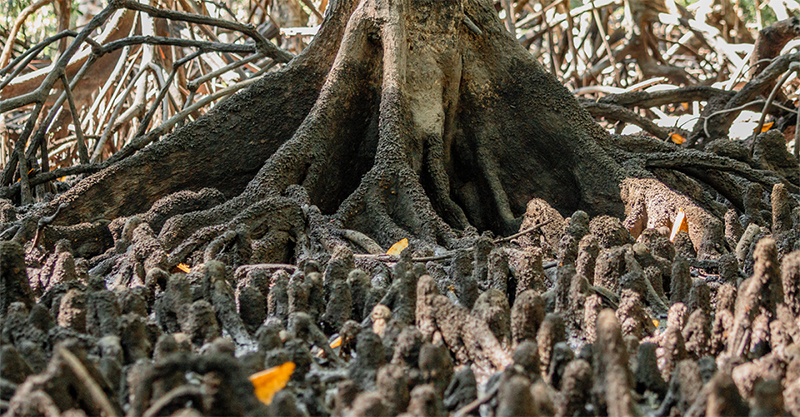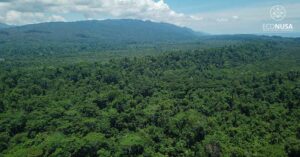
Global warming has brought about climate change which leads to extreme weather that affects global community including Indonesia. Irregular downpour, flooding, landslide and drought in many places are evidently the living examples of climate change in the community including in the Land of Papua. Flooding and landslide in Cycloop Mountain in Sentani, Papua, on March 13, 2019, was the example. The disaster claimed 113 death tolls and caused material losses worth IDR 506 billion. The incident was the learning topic for School of EcoDiplomacy held on 12-15 November 2019. At least, this topic could raise awareness of 22 urban youths from Papua Province on the adverse impact of climate change due to human activities.
Climate change is caused by the rising greenhouse gas (particularly CO2) resulted from human activities (anthropogenic caused) on the earth. Fossil fuel burning that releases dioxide carbon is deemed the major cause (brown carbon). The second cause is emission (release) due to land clearance or natural forest cut, forest fire and emission from agricultural activities including husbandry (that releases methane gas). The third reason is the declining capacity of natural ecosystem to absorb, sequester and pool carbon through photosynthesis process (green carbon). Those three causes have given the largest contribution to emission accumulation on the atmosphere.
Related to the last cause, blue carbon as the carbon pool and carbon sequester every so often is overlooked. The blue carbon is carbon which is absorbed by mangrove ecosystem, brackish swamp and seagrass beds. Carbon is absorbed and pooled by the sea organism is kept in the form of sedimentation. The carbon could be in a large amount of accumulation for not only years or hundred years such as carbon on forest ecosystem, mineral and peat, but thousands of years.
Based on the fact sheet on “Indonesia Blue Carbon Strategy Framework (IBCSF)”, Indonesia with 3.2 million hectares of mangrove is deemed the largest mangrove in the world. It includes mangrove in Bintuni, West Papua, stretching over 259.1 million hectares that potentially keeps 950 MgC per hectare. The similar data shows that the total potential pool of blue carbon in Indonesia is 3.4 gigaton or equal to 17% of global blue carbon pool. Meanwhile, as to Indonesian Institute of Sciences (LIPI), the potential of blue carbon lies in coastal vegetation such as mangrove forest, seagrass beds, brackish swamp and phytoplankton that keeps 77% of carbon higher than that of forest. There are, LIPI mentions, 293,464 hectares of seagrass beds and could absorb 1.9-5.8 mega tons (Mt) of CO2 per year.
According to Jimmy F. Wanma, a researcher from Papua University (Unipa), the Land of Papua has very potential blue carbon. Mangrove Expedition 2019 in collaboration with West Papua Province’s Research and Development Agency (Balitbangda), Unipa and WRI travelled around 1,000 kilometers of coastal ecosystem in Kaimana, Fakfak, Bintuni, South Sorong and Raja Ampat Regencies. The expedition here recorded a total of 424.13 thousand hectares of mangrove which is assumingly pooling 72.2 million tCO2e of the above ground biomass (AGB) carbon. The figure equals to 2.5% of the total target of emission reduction in Indonesia from land sector up to 2030.
There are 378,774 coastal communities in some regencies tracked by the expedition. They depend much on the mangrove ecosystem to meet their livelihood (subsystem). Coastal ecosystem including mangrove ecosystem forms blue carbon. The ecosystem has very significant role as it could increase oxygen level on the coastal water, help recover fish stock, and protect beaches from extreme weather disaster. The real action on the ground that conserves or restores coastal and beach ecosystem should endorsed by integrating initiatives originated by the government, non-government organization, university and other institutions.
In Paris Agreement document from the UNFCCC COP21 in Paris, France, end of 2015, it highlights the role of blue carbon as one of ways to cut down global emission. Despite the agreement, the role of blue carbon has so far not been maximized to cope with climate crises. Indonesia claims to be a country that sides with blue carbon to mitigate climate change. Nurmala Kartini Pandjaitan Sjahrir, an adviser to Presidential’ Special Staff Envoy for Climate Change, on the 2019 Climate Change Conference on June 17-27, 2019 in Bonn, Germany, stated that Indonesia will put blue carbon on the mitigation and adaption of climate change as parts of the national emission reduction target (NDC) in 2020.
Along with the commitment, Presidential Regulation No. 73/2012 on the National Strategy of Mangrove Ecosystem serves as the initial of blue carbon management regulation in Indonesia. The Government of Indonesia has even mainstreamed blue carbon in the National Medium Term Development Plan 2020-2024 through Low Carbon Development Plan (LCDI) as the carbon emission absorber. Currently, the Ministry of Maritime and Fisheries has built an Indonesian Blue Carbon Strategy Framework (IBSF). This is under the national action plan of maritime policy in Indonesia as the umbrella and national action plan for sustainable development goal 2020-2024. For the reason, to increase the ambitious climate change mitigation, the updated of Nationally Determined Contribution (NDC) should include blue carbon as one of the emission reduction efforts in Indonesia.
Hence, the concrete action among parties on the ground could be recorded as part of their contribution to emission reduction. Mangrove ecosystem conservation by the local community is believed to reduce vulnerability and strengthen resilience, while keeping economic growth and Papuan native peoples’ welfare. On the other hand, their efforts could also conserve the blue carbon pool that is very significant to minimize the ongoing climate change pace.
Editor: Leo Wahyudi




